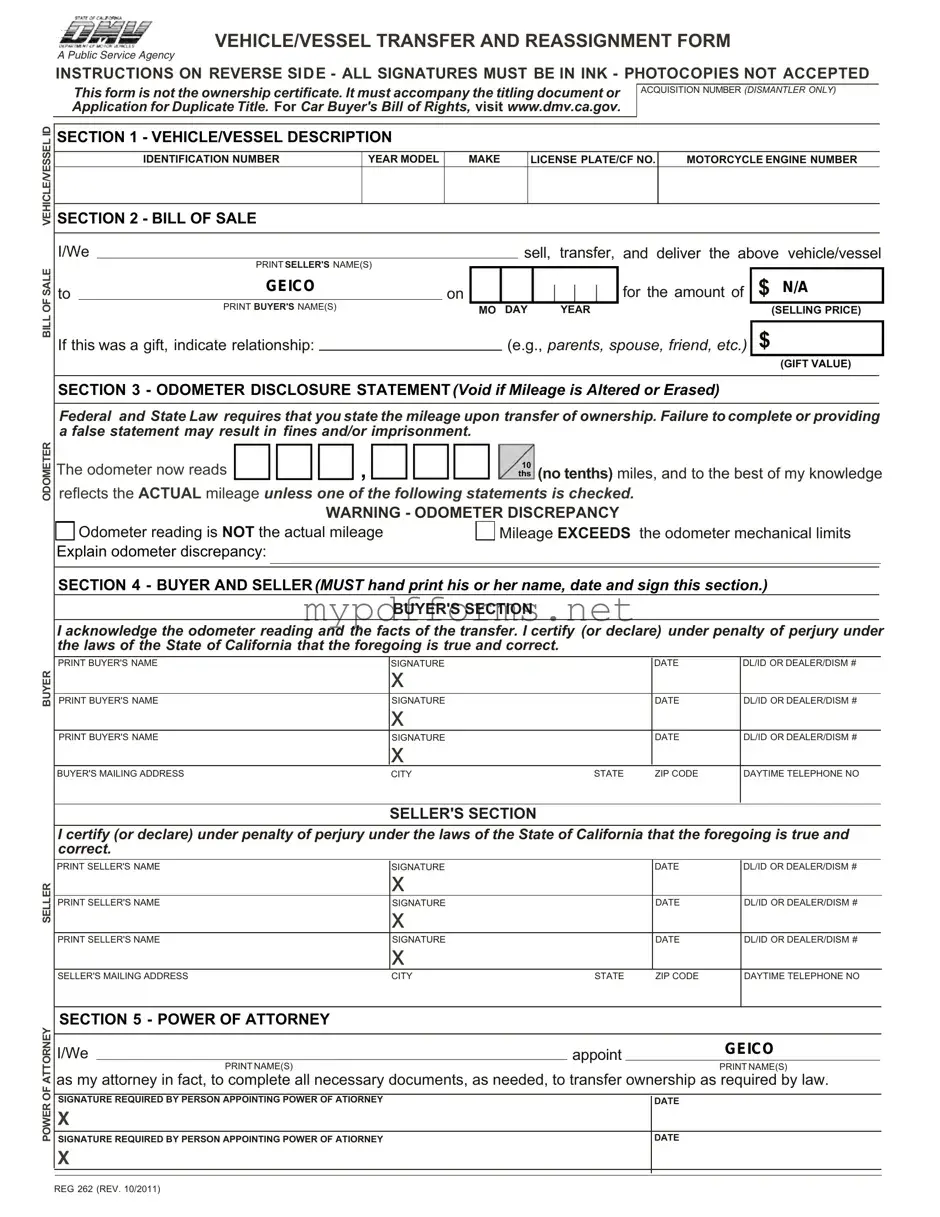The California Form REG 262, which serves as the Vehicle/Vessel Transfer and Reassignment Form, shares similarities with the Bill of Sale. A Bill of Sale is a document that records the transaction between a buyer and seller. It includes essential details such as the names of both parties, the sale price, and a description of the item being sold. Like the REG 262, the Bill of Sale is crucial in establishing proof of ownership transfer. Both documents require signatures from both parties to validate the transaction, ensuring that the buyer has legal grounds to claim ownership of the vehicle or vessel.
Another document similar to the REG 262 is the Odometer Disclosure Statement. This statement is often included as part of the sale documents for vehicles. It requires the seller to disclose the vehicle's mileage at the time of sale, similar to the odometer disclosure section in the REG 262. This disclosure is vital because it protects buyers from potential fraud related to odometer tampering. Both documents emphasize the importance of accurate mileage reporting and include penalties for false statements, underscoring the legal obligations of the seller.
The Vehicle Title is also closely related to the REG 262. A title serves as the official record of ownership for a vehicle or vessel. When transferring ownership, the title must be presented along with the REG 262. Both documents work together to ensure that the transfer is legally recognized. While the title establishes who owns the vehicle, the REG 262 facilitates the transfer process, making it essential for buyers and sellers alike to understand both documents during a sale.
The Application for Duplicate Title is another document that bears resemblance to the REG 262. This application is used when a vehicle's title has been lost or damaged. Just as the REG 262 is required for transferring ownership, the duplicate title application must be submitted to establish new ownership if the original title cannot be located. Both documents require accurate information about the vehicle and the parties involved, ensuring that ownership is correctly recorded with the Department of Motor Vehicles (DMV).
The Power of Attorney form also shares characteristics with the REG 262. This document allows one person to authorize another to act on their behalf in legal matters, including the transfer of vehicle ownership. In the REG 262, there is a specific section where the seller can appoint someone to handle the transfer process. Both forms require signatures to validate the authority being granted, making it essential for ensuring that the person acting on behalf of the owner has the legal right to do so.
The California Vehicle/Vessel Registration Application is another document that aligns with the REG 262. This application is used to register a vehicle or vessel with the DMV. Like the REG 262, it requires detailed information about the vehicle and the owner. Both documents are essential for establishing legal ownership and ensuring compliance with state regulations. When transferring ownership, the registration application is often submitted alongside the REG 262 to facilitate a smooth transition of ownership.
In the realm of vehicle transactions, it is also important to consider other relevant documents, such as the Mobile Home Bill of Sale form, which plays a crucial role in transferring ownership of a mobile home. This form serves not only to identify the parties involved but also to outline the specifics of the agreement, mirroring the protective functions of vehicle sale documentation. Ensuring all pertinent information is accurately recorded can help facilitate a seamless transaction, safeguarding both the buyer and seller against potential disputes.
The DMV Notice of Transfer and Release of Liability is yet another document that is similar to the REG 262. This notice informs the DMV that a vehicle has been sold or transferred, releasing the seller from liability for future incidents involving that vehicle. Like the REG 262, it serves as an official record of the transfer. Both documents protect the interests of the parties involved by ensuring that the DMV has accurate information regarding ownership and liability.
Furthermore, the Vehicle History Report can be seen as complementary to the REG 262. While the REG 262 is primarily focused on the transfer of ownership, the Vehicle History Report provides detailed information about a vehicle's past, including accidents, title changes, and service records. Buyers often request this report to ensure they are making an informed decision. Both documents play a critical role in the vehicle transaction process, as they help establish trust between buyers and sellers.
Finally, the California Car Buyer's Bill of Rights is another important document that relates to the REG 262. This document outlines the rights and protections afforded to consumers when purchasing a vehicle. Similar to the REG 262, it emphasizes the importance of transparency and fair dealing in vehicle transactions. Understanding both the Bill of Rights and the REG 262 helps buyers navigate the complexities of vehicle ownership transfer while ensuring their rights are protected throughout the process.
